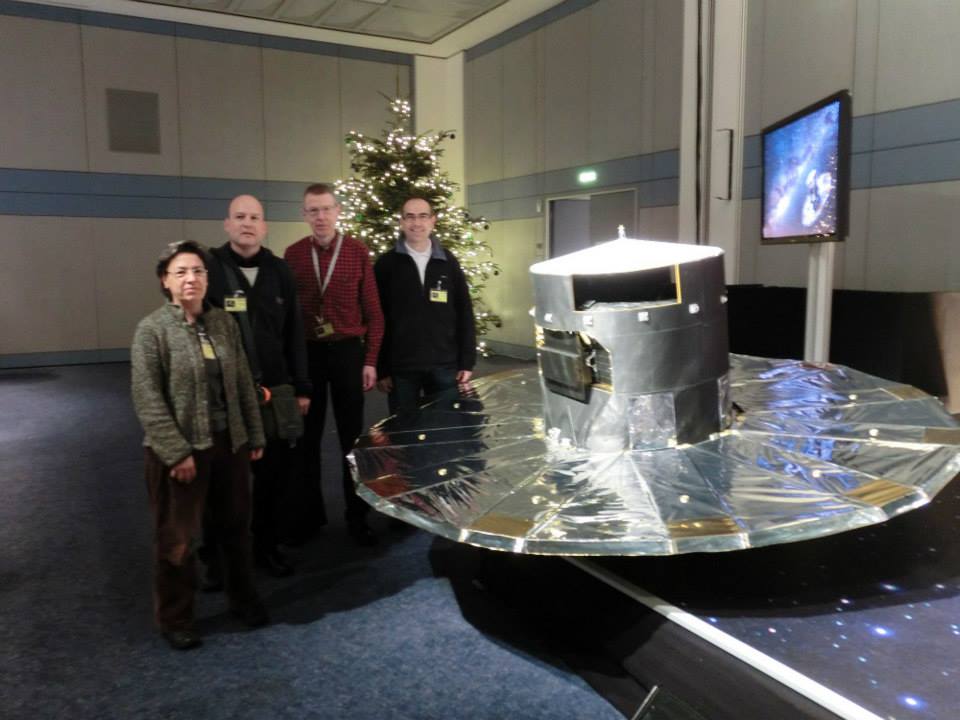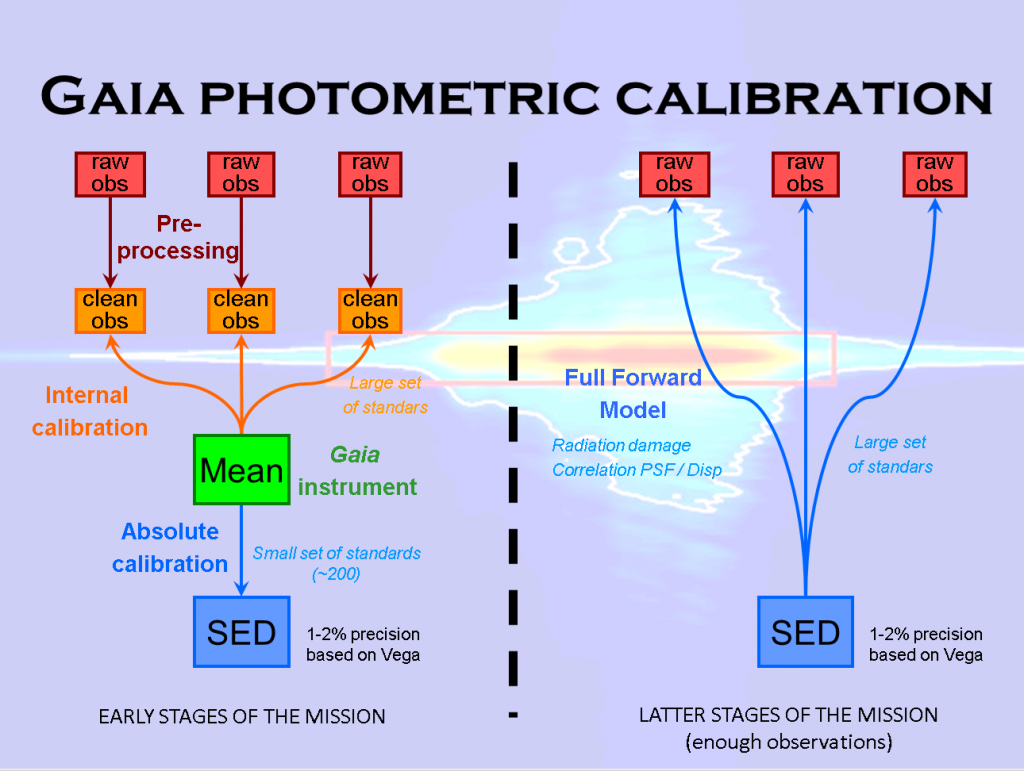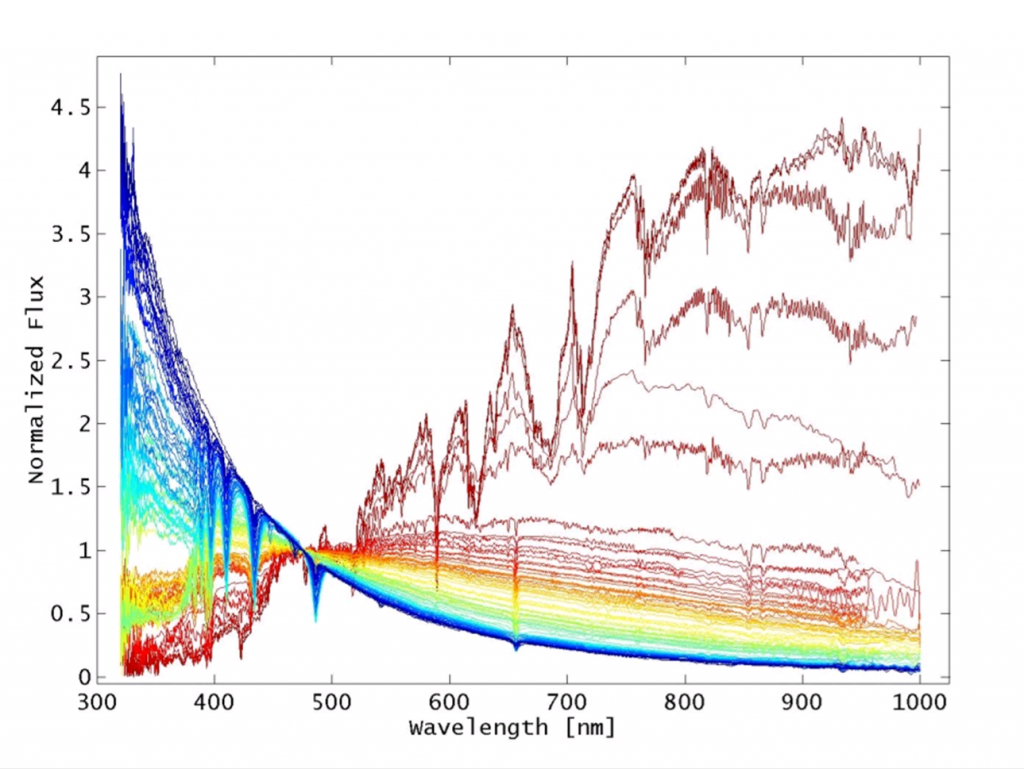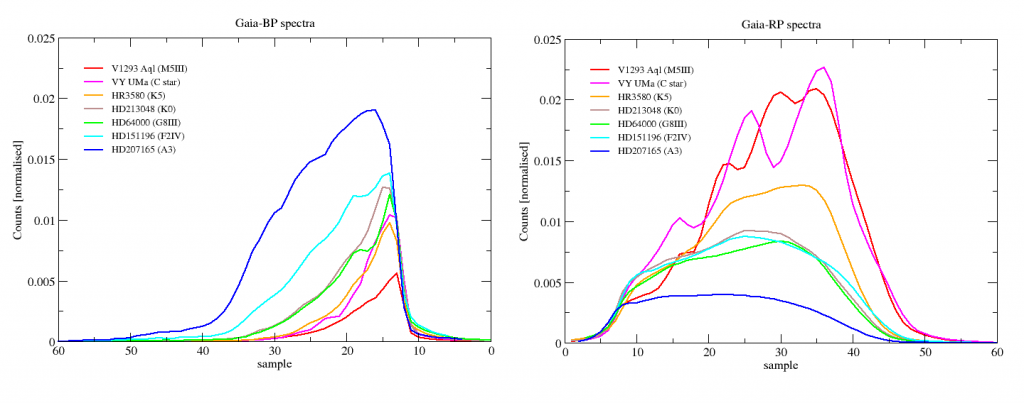CU5: Photometric Processing
We participate in the Photometry Coordination Unit (CU5), in charge of defining and developing the process of treatment, calibration and publishing of photometric and spectrophotometric data. Our group leads DU12 (responsible of the definition of internal calibration models) and DU16 (selection of internal reference sources for the flux and wavelength calibration) and collaborates on the DU13 (ground-based observations for absolute fluxes) and the Payload Experts (to analyse the behaviour of the photometric instrument).
- Current members of CU5 in Barcelona
- DU12: Internal calibration models
- DU13: Ground-based observations for Gaia absolute fluxes
- DU16: Selection of internal reference source
- Payload Experts
Current members of CU5 in Barcelona

CU5 members assisting to Gaia launch event at ESOC (19th Dec 2013)
- Carme Jordi (DU12 and DU16 coordinator, Payload Expert)
- Claus Fabricius (Calibration model & CU3 link, Payload Expert)
- Josep Manel Carrasco (XP spectra calibration, Payload Expert)
- Holger Voss (Passband calibration, Payload Expert)
- Michael Weiler (Full forward model for XP spectra)
- Lola Balaguer (Management)
- Dani Molina (IT)
DU12: Internal calibration models
We have delivered the internal calibration models of photometry and spectrophotometry, including realistic sensitivity variations from flight model CCDs, and flux loss. We have modelled the non-linearity and saturation effects. We have also delivered a simple “aij” model for the calibration of low-resolution spectroscopy for the early phases of the mission, and we are developing a full-forward model for the latest phases when enough data will be collected for such complex approach. The implementation of our methods has been made in DPCI (IoA Cambridge) and runs there, and we are providing support for verification on the obtained results. We have already made many exercises with simulated data and evaluated the expected performances.
The results with real data are checked against these expected values and new simulations are performed to help understanding deviations that may appear (validation of the calibration of CCD-to-CCD, column-to-column and FoV-to-FoV differences in sensitivity, aperture correction, geometry and spectral dispersion).
The level of complexity of the methods increase along the mission: the larger the amount of data available the deeper analysis is needed, because more subtle effects can be calibrated. So, the tuning of the algorithms is needed. When enough data is collected we aim to calibrate spectrophotometry with the real Gaia data using on-ground data for spectrophotometric standard stars (full-forward model approach).
Comparison of the two models proposed for XP photometric calibration (aij approach at left and full-forward model at right)
DU13: Ground-based observations for Gaia absolute fluxes
We are contributing to the observational program (leaded by Bologna Observatory team) devoted to acquire absolute photometry and spectrophotometry of a set of selected Spectrophotometric Standard Stars (SPSS) to be used as standards for Gaia absolute flux and wavelength calibration.
To complete the on-ground data, we submit observational proposals to the available facilities to us (Roque de los Muchachos, CAHA, Montsec, San Pedro Mártir, …) and participate in the observational campaigns. We also contribute in the definition of well established protocols and strategies for observation and data reduction.
The campaigns are almost completed although we still need to continue monitoring the variability (short and long term) in order to discard non optimal candidates. More information can be found in Bologna Wiki pages (password required) and our local webpage devoted to observational runs
A first release of the SPSS catalogue was done before launch in order to be ready to assess the performance of the instrument during commissioning.
DU16: Selection of internal reference source
Due to the large amount and many different types of sources observed by Gaia and the complexity of the instrument (with 106 CCDs, XP spectra with variations in dispersion with the position of the focal plane, …), this mission cannot only be calibrated by a limited amount of sources. Gaia is a self-calibrated mission, using million of constant sources to compare their observations from different positions, times and observing conditions. DU16 deals with the automatic selection of these ‘million’ internal sources to relate every individual observation into a common mean instrumental system.
After a detailed study of the possible alternatives a rather complex algorithm was coded in collaboration with DU15 (Cambridge) allowing to select reference stars based on their magnitude, colour and sky distribution in the framework of the pipeline Photpipe. The last integration test showed that the selection process is working fine.
The validation of the calibration methods for photometry and spectrophotometry and selection of reference stars currently delivered and implemented are being checked with real data.
Payload Experts
We have been also contributing to Payload Experts work during commissioning phase, basically evaluating G and XP performance. Spanning from launch to In-Orbit Commissioning Review (IOCR), this period is devoted to assess the health of the satellite and to complete the readiness of software critical items for the nominal mission. Our contributions were included in the IOCR document and IDT First Look weekly reports:
- Focus evaluation
- Saturation effects
- Evaluation of gate activation strategy: Verification of the suitability of the pre-launch established strategy with real data (see Gaia blog entry).
- Passband response (effect of contamination) in global response and passband shape.
- Straylight effects (in G, XP passbands and spectra) and possible causes
- Evaluation of spectral dispersion of photometric instrument: Determination of the spectral dispersion of BP and RP through comparison of real data with on-ground spectra of known objects.
- Multiple detections in IDT








